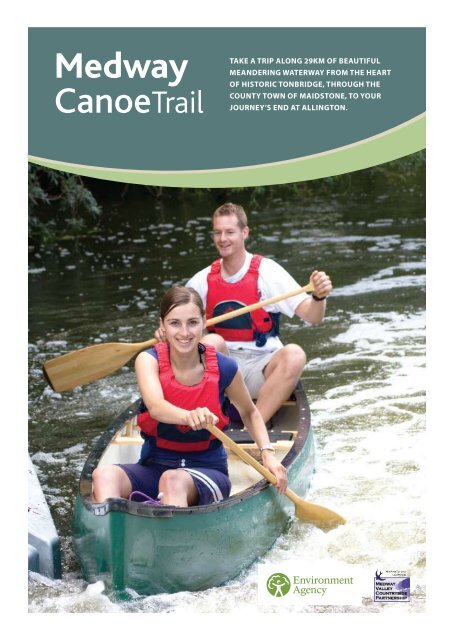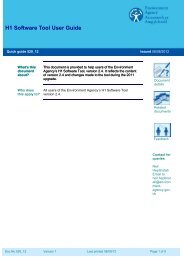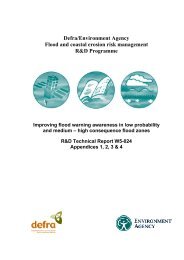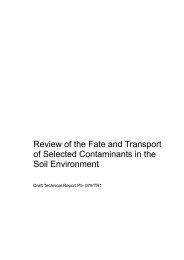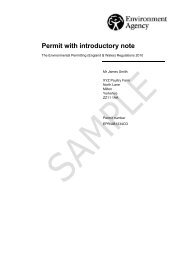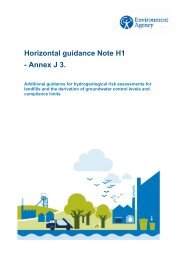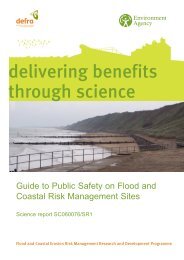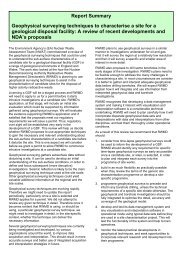Medway canoe trail
Medway canoe trail
Medway canoe trail
- No tags were found...
You also want an ePaper? Increase the reach of your titles
YUMPU automatically turns print PDFs into web optimized ePapers that Google loves.
<strong>Medway</strong>CanoeTrailTake a trip along 29km of beautifulmeandering waterway from the heartof historic tonbridge, through thecounty town of maidstone, to yourjourney’s end at allington.
<strong>Medway</strong> Canoe TrailRising in the Ashdown Forest, the River <strong>Medway</strong> flowsthrough West and East Sussex and into Kent beforereaching the Thames estuary some 120 kilometresdownstream. Many tributaries flow into the <strong>Medway</strong> as itpasses through the High Weald and Vale of Kent with itscharacteristic orchards and meadows.You can enjoy 29 kilometres of this majestic river startingfrom Tonbridge and finishing at Allington Lock, its tidal pointjust north of Maidstone. Graded easy, it can be <strong>canoe</strong>d in acouple of days, or longer for a more relaxed trip. There are anumber of campsites and launch points along the route.Paddling along the river you willsee a wide variety of riversideplants, from the colourful purpleloosetrife to the blue of the waterforget-me-not. The orange andblue flash of the kingfisher and - ifKingfisheryou are very lucky - a glimpseof an otter are just some of the wonders awaiting youalong the River <strong>Medway</strong>. The <strong>trail</strong> meanders past woods,meadows, villages and towns with a wealth of interest.HeritagePeople have lived in the <strong>Medway</strong> Valley since theNeolithic times on the fertile soils alongside the river.The <strong>Medway</strong> has been a hive of activity as a transportroute taking ragstone up to London, and iron andtimber from the Weald to the docks. This industry wasmade possible in the 1740’s with the extension of thenavigation up to Tonbridge. In Tonbridge the riverprovided power to run the Leigh gunpowder works inthe 1800’s.Agriculture was a prime industry in the early 20thCentury with two thirds of England’s hops producedin Kent. Hop gardens can still be seen alongside theriver at Golden Green, although they are far fewer innumber today.Also keep an eye out for pill boxes along the length ofthe river, built to defend the county in World War Two.Today you can enjoy the river’s wildlife, tranquillity andexcitement from the water or from its banks.Section 1 START - Tonbridge Castle toTown Lock, Tonbridge (0.5km)Tonbridge CastleWelcome to the start of the <strong>trail</strong>at Tonbridge. Access to the slipwayis via the Lower Castle Field carpark (off The Slade). Please notea height barrier is present (Ifthe barrier is down please visitthe neighbouring TonbridgeSwimming Pool for access).Prior to getting on the water, why not take a stroll around thetown of Tonbridge and visit the Castle which boasts Kent’sbest example of a Motte-and-Bailey Gatehouse. The original11th Century wooden structure has been replaced by stone.Tonbridge is the upper limit of the <strong>Medway</strong>’s navigation,enabling you to explore the river valley down through tothe tidal section at Allington.Following the river downstream you will pass TonbridgeTown Bridge to reach Tonbridge Lock.Section 2 - Tonbridge Town Lock toEldridges Lock (2.4 km)Paddling downstream under Cannon Lane Bridge younow head into the countryside of the <strong>Medway</strong> Valley.Alongside the river you’ll see wet meadows dotted withanthills. You might even see green woodpeckers feedingon the ants if you are lucky.Passing under a girder bridge you then reach Eldridges Lock.Keep your eyes and earsopen for barn owls feedingover grassland areas at dusk.Feeding on field voles and mice,their almost silent flight helpsthem to approach their preyBarn Owlundetected. Barn owls make avariety of noises from hisses to shrieks but don’t hoot(that is the Tawny Owl).Did you know that it’s been estimated that over ayear, a breeding pair of barn owls need roughly 4,000prey items?
Section 3 -Eldridges Lock to Porters Lock(1.6km)Continuing downstream youwill reach Porters Lock whereyou can either use the fishfriendly<strong>canoe</strong> pass or theportage platforms which arenear to the lock.Grey HeronPorters Lock Canoe PassThe pass helps fish moveup the river so they can take advantage of the bestspawning and feeding grounds.The <strong>Medway</strong> boasts more than 21 species of freshwaterfish, popular with anglers who catch, amongst otherspecies, Roach, Dace, Pike, Eels and Sea Trout.When travelling along the River <strong>Medway</strong> during thesummer months you will see fish swimming nearthe surface. These fish are likely to be Bleak or Chub,enjoying the warmer waters and feeding on flies.The biggest fish you are likely to find in the riveris the Pike. Pike are opportunistic feeders and cangrow more than a metre in length. They are a keycomponent in maintaining a healthy population offish within the river.Section 4 -Porters Lock to East Lock (2km)The <strong>trail</strong> continues under Hartlake Bridge where thereis a separate access point to the river (suits open,Canadian type <strong>canoe</strong>s only). Along this section youwill see the characteristic riverside trees such as alderand willow lining the banks. The telltale characteristicsof the yellow male catkins and red flowers of the aldercan be seen around March time before the leaveshave come out.You may see the majestic greyheron, often seen standingsilently along the river. It’sone of the first birds to startnesting in spring and does sohigh in the trees.Section 5 -East Lock to Oak Weir Lock (1.2km)Soon you will be at Oak Weir Lock with the lowerportage platform off to the left via a small path throughthe lock island itself. Feel free to camp here.If you are very lucky you mayspot an otter whilst on the water.These secretive mammals feedon fish and amphibians and livea discreet life in holts along theriver. Often only their tracks andspraints containing fish scalesshow their presence.DamselflyBlue TitSecretive otterSection 6 -Oak Weir Lock to Sluice Weir Lock (2km)Passing under Stilstead Bridge, the river winds its wayonwards under the metal Wagon Bridge. Look out for thewooden footbridge on your right and go underneaththis to find the Hop Farm Campsite.Continuing on to Sluice Weir Lock you have the opportunityto use the <strong>canoe</strong> pass or the portage platform.In spring and summer theriver is alive with dragonfliesand damselflies in the marginalvegetation along the riverand dykes.Section 7 -Sluice Weir Lock to Hampstead Lock (3.6km)Passing through the village of East Peckham you’ll reachStoneham Old Lock (now disused) where you can camp(no facilities). The river meanders its way to Yalding withan abundance of wildlife.Birds such as the song thrush,tree sparrow and blue tit canbe seen in the hedgerows andtraditional orchards that rundown to the river’s edge.
Apple orchardTeston BridgeDid you know that Yalding wasknown for its cherry orchards,and in the Roman periodevidence suggests vineyardswere present?Paddling into Yalding you havetwo route choices.Option 1 - Upstream of the booms (on the right hand side)is one exit point where you need to climb up the bankand then drop down the other side to a small stream (TheRiver Teise). From the stream you enter the weir pool andcan then go under the stone bridge with the Marlin CanoeClub’s campsite nearby (booking needed). Option 2 - Theother option for you is to continue past the Anchor Innon your left and proceed down the canal passing underthe low green bridge. Just after this point are toilets andshowers, and there is a platform on your right if you wantto get out. This is Yalding access point. After this continuedown the canal until you reach Hampstead lock where the<strong>canoe</strong> portage platform is on your right.Either way, why not visit Tea Pot Island and café alongsidethe sluice which has more than 6,000 teapots.Section 8 -Hampstead Lock to Teston Lock (4.8km)Carrying along the river past the moored boats you rejointhe main river (if you chose the canal route option).Passing boats at Wateringbury marina, you thenpaddle downstream to Teston with Wargraves Woodon your right. The wood boasts a mix of ash, coppiceand oak standards and is a riot of bluebells and woodanemones in the spring.Soon you will reach Teston Lock which runs alongsideTeston Bridge Country Park. The park is a great place fora picnic and walk, with grassland and wet meadows.An unusual fact! Did you knowthat Teston is the home ofcricket balls? The companynow known as Readers wasestablished in 1808 further upthe hill in the village centre.From cricket balls to bats - if you are paddling at duskor dawn in the summer, Daubenton’s bats (oftennicknamed the water bat) can be seen feeding oninsects by skimming over the surface of the water andplucking them off with their feet!Section 9 -Teston Lock to East Farleigh Lock (3.2km)Beyond Teston, the river becomes wider with a mosaicof orchards, gardens and woodlands running alongside.Just before Barming footbridge you will see a campsiteon the right hand bank.Did you know that beforethe installation of the locks,the river was fordable here atBarming? The wooden bridgewas replaced in 1996 by thecurrent metal footbridge.Paddling along TestonTraditionally, local Morrisdancers,known as the “KettleBridge Clogs”, dance over thefootbridge each year on 1st May.Downstream of Barming theKettle Bridge Clogs onthe old wooden bridge village of East Farleigh is reached,with the church spire visibleon the hill. Reaching East Farleigh Bridge you can paddlethrough the arches to reach the platform. The bridge has itsown claim to fame with the ‘Battle of East Farleigh Bridge’taking place in 1648, during the ‘Second’ English Civil War.Section 10 -East Farleigh Lock to Allington Lock(7.2km)The <strong>trail</strong> flows from a villagesetting into the town centreof Maidstone where old mixeswith new. The 14th CenturyArchbishop’s Palace is distinctive,Under East Farleigh Bridgeused originally as an overnightstop when the archbishop wastravelling between London and Canterbury. This is incontrast to the modern developments further downstream.
Section 10 - East Farleigh Lock toAllington Lock (7.2km) cont...Archbishop’s PalaceTravelling beyond Maidstone, youmay glimpse the double helixart sculpture in the WhatmanMillennium Park on your left.Here you can enjoy a mix oflandscaped park, woodland,amenity areas and natural openspaces alongside the river.Heading towards Allington Lock the stately AllingtonCastle, now a private residence, is visible on the leftthrough the trees.Very soon on your right is theMalta Inn, one of four publichouses situated by the River<strong>Medway</strong> which were built in the18th Century and all named afterBritish Naval bases. Two of thefour are near Chatham, but another one, the Gibraltar Inn(now a private residence), is a few yards up the river fromthe Malta pub.Section 11 - Finish – Allington LockCongratulations you havereached the end of the <strong>trail</strong>!Allington Lock Slipway is on theleft by the timber-clad boater’sfacility. Here you can take a wellearnedshower and rest.The end of the <strong>trail</strong> -Allington Slipway and<strong>canoe</strong> launch point Why not take a wander across thesluice to the Museum of Kent Lifeor enjoy refreshment at the Malta Inn? You can continue toenjoy your trip by camping at Allington Lock and meetingthe Lock Keepers who look after the river at this tidal point.ContactsEnvironment Agency(emergency hotline) – 0800 807060www.visitrivermedway.co.ukAllington Lock (EA) – 01622 752864www.allingtonlock.co.uk<strong>Medway</strong> Valley Countryside Partnershipwww.medwayvalley.orgTonbridge Tourist Informationvia www.tmbc.gov.ukMaidstone Tourist Informationwww.tour-maidstone.comExplore Kentwww.kent.gov.uk/explorekent.Canoe Englandwww.<strong>canoe</strong>-england.org.ukBritish Canoe Union - 0115 982 1100www.bcu.org.ukTonbridge Canoe Clubwww.tonbridge<strong>canoe</strong>club.org.ukMaidstone Canoe Clubwww.maidstone<strong>canoe</strong>club.netWhitewater Action <strong>Medway</strong>www.whitewateraction.co.uk
LicencesYou are required to be licenced to use a vessel on the river<strong>Medway</strong> (Allington to Tonbridge). This can either be through BCUmembership (please display your sticker/licence) or by purchasinga licence from the following places: short term (weekly, monthly)licences can be obtained from Allington Lock (01622 752864),Bow Bridge Marina (01622 812802), <strong>Medway</strong> Wharf Marina (01622813927), Allington Marina (01622 752057), Tonbridge TouristInformation Centre (01732 770929) and the Environment AgencyKent and East Sussex Area Office (01732 223222). Annual licences(April 1st to March 31st) can only be obtained from the EA Kent andEast Sussex Area Office (contact above).Camping FacilitiesCamping is available along the <strong>trail</strong> at the following sites(varying degrees of facilities)Hop Farm Campsitewww.thehopfarm.co.uk/touring-camping/Stoneham Lock (no facilities)TQ681 489- contact EA - 01622 752864Marlin Canoe Club Campsite (Yalding)TQ 691 499 booking required 02086500197Barming Bridge CampsiteTQ720 538 01622 720263Allington LockTQ746 582 contact EA 01622 752864Oak Weir (no facilities)TQ472 654 contact EA 01622 752864AccessibilityAllington Lock has toilets, showers and parking alongside theslipway and is accessible for wheelchair users. However, otherplaces are more remote. There are landing stages at each lock withsome locks having <strong>canoe</strong> passes.
Be Safe and Look After Our River1. Respect the river and other users by leaving no trace of yourvisit and minimising disturbance to wildlife by exiting theriver at designated areas only.2. Keep a lookout for anglers, maintain a good distance from themto avoid their tackle and create as little disturbance as possible.3. Keep a safe distance from motor cruisers and rowing craft,particularly when racing or coaching is taking place. Rememberit is difficult for rowing craft to see <strong>canoe</strong>s. For the same reasondo not follow close astern of larger vessels.4. Buoyancy aids or life jackets should be worn at all times andwe recommend that those on the water are able to swim.5. We recommend that <strong>canoe</strong>ists have some prior formalinstruction and do not <strong>canoe</strong> alone.6. If on the water after sunset, an all-round white light shouldbe displayed and you should wear light coloured tops so youcan be seen.7. Be prepared and wear suitable clothing for the weather.Remember, prolonged immersion in cold water cancause hypothermia.8. Do not <strong>canoe</strong> just above weirs or try to shoot weirs; the orangebooms are there for your safety; please do not go under them.9. In case of an emergency, phone the Environment Agencyhotline number and contact the Emergency Services.in partnership with
STARTTONBRIDGE SLIPWAY 1FootbridgeRail bridgeLucifer footbridgeTONBRIDGETONBRIDGE TOWN LOCK2Cannon BridgeTonbridge BridgeSEASONALWATERINGBURYBow BridgeHAMPSTEAD LOCK8YALDINGTwyford BridgeSLUICE WEIR LOCK7Option 2Lifting BridgeOption 1FootbridgeEAST LOCK5EAST PECKHAMStoneham Old Lock (Disused)Rail bridgeELDRIDGES LOCK3GOLDENGREENFord Green BridgeStilstead Bridge(200m walk)Hop FarmHartlake Bridge4PORTERS LOCK6OAK WEIR LOCKto Paddock WoodOS Maps Explorer 148 and 136 (1:25 000)Teston Bridge
LONDONDartfordEbbsfleetGravesendRochesterGillinghamChathamSevenoaksMaidstoneTonbridgeRoyalTunbridgeWells0 1 2 kmKeyShopPublic houseCampingToiletsFresh waterSlipwayParkingPoint of InterestDisabled ToiletsMargateRamsgateSittingbourneFavershamSandwichCanterburyDealAshfordDoverFolkestoneEating place/mealsAccess pointShowerDisabled ParkingSEASONALWATERINGBURYBow BridgeHAMPSTEAD LOCK8YALDINGTwyford BridgeSLUICE WEIR LOCKOption 2Lifting BridgeOption 1ALLINGTON LOCK11Barming FootbridgeTeston BridgeEAST FARLEIGHEast Farleigh Bridge9TESTON LOCKSEASONALFINISHALLINGTONFootbridgeFootbridgeMAIDSTONERail bridgeMaidstone BridgeNew Bridgeto AshfordFootbridgeEAST FARLEIGH LOCK10


